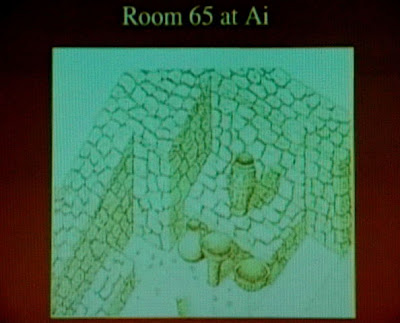
Among some fascinating streaming-video available on the Yale Divinity School website is this lecture on household religion in ancient Israel and women's place in the practice of household religion. The video is a little over an hour long, and is well worth viewing. It was recorded at Yale Divinity School on Tuesday, January 31, 2006, 5:15pm. Susan Ackerman is Professor of Religion and of Women's and Gender Studies and chair of the Department of Religion at Dartmouth College.
To access the streaming video on the YDS WebSite, click
here.
Let me highlight a few of the fascinating ideas that the video presents. First, take a look at her slide of Room No. 65 within an extended-family compound at ancient Ai.

Room 65 seems to be a distinct / dedicated shrine room within a family compound. It is not just an area within a dwelling unit (such as the area that can be observed within House 440 at Tell el-Far'ah North) but a room of its own. The room's dimensions are about 28' x 10'. There is a drainage channel in the room, probably to drain libation offerings (which could have been offered to God by the women of the compound). In the video, Ackerman uses the evidence from Ai to illuminate Judges 17-18 and the data that it may furnish us about household religion. She believes that the silver-plated figurine of the Judges text represented Israel's God YHWH, and that it stood on the sort of bench-platform that formed the focal location of the dedicated shrine in the Ai compound.

In this next slide, we have a close-up of the type of object that could stand on the bench-platform of a shrine room. In the case of Ai, the focal image was a pottery object that may have represented a temple with windows and with the deity's feet extending out toward the bottom. This would have symbolized the deity's presence at the shrine room. Ackerman notes in her lecture that in ancient Israel, women often made the pottery of a household, and could well be responsible for this focal object at Ai. In the Judges 17-18 story, the focal object plated with silver could have been a calf-image, such as the ones later set up at Dan and Bethel. Ackerman notes that the Judges text makes clear that it was a woman who furnished this focal object for the shrine room, specifically Micah's mother.
Ackerman makes clear towards the end of the presentation that at least the editors of Judges 17-18 looked with disfavor on the existence of the divine image / focal object in the story. First, the larger narrative makes clear that the figurine was produced from questionable, stolen silver. Second, the figurine, according to the story, ended up itself being stolen from the family compound and taken to Dan, casting a negative light on the worship objects of Dan as possibly obtained through immoral means.






0 Comments:
Post a Comment
<< Home